Degradation Mechanism and Online Electrical Monitoring Techniques of Stator Winding Insulation in Inverter-Fed Machines: A Review
Abstract
1. Introduction
- (1)
- An analysis of four types of stress leading to stator winding insulation failure in AC motors, including the failure mechanisms associated with each stress. The study also summarizes the coupling effects of multiphysics fields on stator insulation failure and the overall process from insulation degradation to failure.
- (2)
- A comprehensive review of online monitoring methods for stator insulation conditions developed in recent years. We classify these methods into four categories. The latest research is reviewed and summarized for each online monitoring method, including monitoring principles, techniques, advantages, and limitations. The main contributions and shortcomings of each study are discussed.
- (3)
- In the conclusion and discussion section, this paper provides a summary and further discusses unresolved issues and potential improvements in current research. Particular attention is given to the feasibility and accuracy of these methods in practical applications.
2. Insulation Degradation Mechanism under Multi-Physics Field
2.1. Electrical Stress
2.2. Thermal Stress
2.3. Mechanical Stress
2.4. Ambient Stress
2.5. Interrelationships of Stresses
3. Online Electrical Monitoring Techniques of Stator Winding Insulation
3.1. Methods Based on Partial Discharge
3.2. Methods Based on Time-Frequency Characteristics of Leakage Currents
3.3. Methods Based on Broadband Impedance Spectrum
- (1)
- Low-Frequency Range.
- (2)
- Mid- and High-Frequency Range.
3.4. Methods Based on High-Frequency Current Ringing
3.5. Summary of Methods
4. Conclusions and Discussion
Funding
Data Availability Statement
Acknowledgments
Conflicts of Interest
References
- Zhang, P.J.; Du, Y.; Habetler, T.G.; Lu, B. A Survey of Condition Monitoring and Protection Methods for Medium-Voltage Induction Motors. IEEE Trans. Ind. Appl. 2011, 47, 34–46. [Google Scholar] [CrossRef]
- Bell, R.N.; McWilliams, D.W.; O’donnell, P.; Singh, C.; Wells, S.J. Report of Large Motor Reliability Survey of Industrial and Commercial Installations. 1. IEEE Trans. Ind. Appl. 1985, 21, 853–864. [Google Scholar]
- Drif, M.; Cardoso, A.J.M. Stator Fault Diagnostics in Squirrel Cage Three-Phase Induction Motor Drives Using the Instantaneous Active and Reactive Power Signature Analyses. IEEE Trans. Ind. Inform. 2014, 10, 1348–1360. [Google Scholar] [CrossRef]
- Tallam, R.M.; Habetler, T.G.; Harley, R.G. Experimental testing of a neural-network-based turn-fault detection scheme for induction machines under accelerated insulation failure conditions. In Proceedings of the IEEE International Symposium on Diagnostics for Electric Machines, Power Electronics and Drives, Atlanta, GA, USA, 24–26 August 2003. [Google Scholar]
- Zheng, D.; Zhang, P. A Review of Fault Diagnosis and Online Condition Monitoring of Stator Insulation in AC Electrical Machine. Proc. Chin. Soc. Electr. Eng. 2019, 39, 395–406. [Google Scholar]
- Mazzoletti, M.A.; Bossio, G.R.; De Angelo, C.H.; Espinoza-Trejo, D.R. A Model-Based Strategy for Interturn Short-Circuit Fault Diagnosis in PMSM. IEEE Trans. Ind. Electron. 2017, 64, 7218–7228. [Google Scholar] [CrossRef]
- Sahin, I.; Keysan, O. Model Predictive Controller Utilized as an Observer for Inter-Turn Short Circuit Detection in Induction Motors. IEEE Trans. Energy Conver 2021, 36, 1449–1458. [Google Scholar] [CrossRef]
- Mahmoudi, A.; Jlassi, I.; Marques Cardoso, A.J.; Yahia, K.; Sahraoui, M. Inter-Turn Short-Circuit Faults Diagnosis in Synchronous Reluctance Machines, Using the Luenberger State Observer and Current’s Second-Order Harmonic. IEEE Trans. Ind. Electron. 2022, 69, 8420–8429. [Google Scholar] [CrossRef]
- Ehya, H.; Nysveen, A. Pattern Recognition of Interturn Short Circuit Fault in a Synchronous Generator Using Magnetic Flux. IEEE Trans. Ind. Appl. 2021, 57, 3573–3581. [Google Scholar] [CrossRef]
- Chen, Y.; Rehman, A.U.; Zhao, Y.; Wang, L.; Wang, S.; Zhang, M.; Zhao, Y.; Cheng, Y.; Tanaka, T. Numerical Modeling, Electrical Characteristics Analysis and Experimental Validation of Severe Inter-Turn Short Circuit Fault Conditions on Stator Winding in DFIG of Wind Turbines. IEEE Access 2021, 9, 13149–13158. [Google Scholar] [CrossRef]
- Zhang, J.; Xu, Z.; Wang, J.; Zhao, J.; Din, Z.; Cheng, M. Detection and Discrimination of Incipient Stator Faults for Inverter-Fed Permanent Magnet Synchronous Machines. IEEE Trans. Ind. Electron. 2021, 68, 7505–7515. [Google Scholar] [CrossRef]
- Oner, M.U.; Sahin, I.; Keysan, O. Neural Networks Detect Inter-Turn Short Circuit Faults Using Inverter Switching Statistics for a Closed-Loop Controlled Motor Drive. IEEE Trans. Energy Conver 2023, 38, 2387–2395. [Google Scholar] [CrossRef]
- Toma, S.; Capocchi, L.; Capolino, G.-A. Wound-Rotor Induction Generator Inter-Turn Short-Circuits Diagnosis Using a New Digital Neural Network. IEEE Trans. Ind. Electron. 2013, 60, 4043–4052. [Google Scholar] [CrossRef]
- Shih, K.-J.; Hsieh, M.-F.; Chen, B.-J.; Huang, S.-F. Machine Learning for Inter-Turn Short-Circuit Fault Diagnosis in Permanent Magnet Synchronous Motors. IEEE Trans. Magn. 2022, 58, 8204307. [Google Scholar] [CrossRef]
- Grubic, S.; Aller, J.M.; Lu, B.; Habetler, T.G. A Survey on Testing and Monitoring Methods for Stator Insulation Systems of Low-Voltage Induction Machines Focusing on Turn Insulation Problems. IEEE Trans. Ind. Electron. 2008, 55, 4127–4136. [Google Scholar] [CrossRef]
- IEEE 275-1992; IEEE Recommended Practice for Thermal Evaluation of Insulation Systems for Alternating-Current Electric Machinery Employing Form-Wound Preinsulated Stator Coils for Machines Rated 6900 V and Below. IEEE: Piscataway, NJ, USA, 1992; pp. 1–14. [CrossRef]
- Cai, Z.; Wang, X.; Li, L.; Hong, W. Electrical treeing: A phase-field model. Extrem. Mech. Lett. 2019, 28, 87–95. [Google Scholar] [CrossRef]
- Dehlinger, N.; Stone, G. Surface partial discharge in hydrogenerator stator windings: Causes, symptoms, and remedies. IEEE Electr. Insul. Mag. 2020, 36, 7–18. [Google Scholar] [CrossRef]
- Lee, H.; Kim, H.; Jeong, J.; Lee, K.; Lee, S.B.; Stone, G. Inverter-Embedded Partial Discharge Testing for Reliability Enhancement of Stator Winding Insulation in Low Voltage Machines. IEEE Trans. Ind. Appl. 2022, 58, 2088–2096. [Google Scholar] [CrossRef]
- Tang, Y.; Liu, X.; Wang, J.; Guo, Y.; Liu, Y.; Li, D. Electrical Tree Characteristics in Winding Insulation for Inverter-fed Traction Motor under Repetitive Impulse Voltages. High Volt. Eng. 2023, 49, 2625–2633. [Google Scholar]
- Sun, P.; Sima, W.; Jiang, X.; Zhang, D.; He, J.; Ye, L. Review of accumulative failure of winding insulation subjected to repetitive impulse voltages. High Volt. 2019, 4, 1–11. [Google Scholar] [CrossRef]
- Li, H.; Liu, J.Y.; Xiang, D.W.; Gu, Y. Feature Extraction and Decoupling of Line-end Coil Insulation for Inverter-fed Machine Using High-frequency Differential Mode Switching Oscillation. Proc. Chin. Soc. Electr. Eng. 2024, 44, 1608–1618. [Google Scholar] [CrossRef]
- IEC TS 61934:2024; Electrical Insulating Materials and Systems–Electrical Measurement of Partial Discharges (PD) under Short Rise Time and Repetitive Voltage Impulses. IEC: New York, NY, USA, 2024; pp. 1–31.
- Liu, K.; Zhang, K.; Hua, W.; Hu, M.J. Efficiency Optimization Control of Permanent Magnet Synchronous Motor Drive System Based on Variable Carrier Frequency. J. Southeast Univ./Dongnan Daxue Xuebao 2024, 54, 724–729. [Google Scholar]
- Farahani, M.; Gockenbach, E.; Borsi, H.; Schaefer, K.; Kaufhold, M. Behavior of Machine Insulation Systems Subjected to Accelerated Thermal Aging Test. IEEE Trans. Dielectr. Electr. Insul. 2010, 17, 1364–1372. [Google Scholar] [CrossRef]
- Chen, P.; Xie, Y.; Li, D. Thermal Field and Stress Analysis of Induction Motor with Stator Inter-Turn Fault. Machines 2022, 10, 504. [Google Scholar] [CrossRef]
- Istad, M.; Runde, M.; Nysveen, A. A Review of Results from Thermal Cycling Tests of Hydrogenerator Stator Windings. IEEE Trans. Energy Conver. 2011, 26, 890–903. [Google Scholar] [CrossRef]
- Siddique, A.; Yadava, G.S.; Singh, B. A review of stator fault, monitoring techniques of induction motors. IEEE Trans. Energy Conver. 2005, 20, 106–114. [Google Scholar] [CrossRef]
- Lin, F.; Zuo, S.; Deng, W.; Wu, S. Modeling and Analysis of Electromagnetic Force, Vibration, and Noise in Permanent-Magnet Synchronous Motor Considering Current Harmonics. IEEE Trans. Ind. Electron. 2016, 63, 7455–7466. [Google Scholar] [CrossRef]
- Stone, G.C.; Maughan, C.V.; Nelson, D.; Schultz, R.R. Impact of slot discharges and vibration sparking on stator winding life in large generators. IEEE Electr. Insul. Mag. 2008, 24, 14–21. [Google Scholar] [CrossRef]
- Rauber, A.; den Bakker, P. Stator End-Winding Vibration in Two-Pole Machines: Avoiding Generator Failure. IEEE Ind. Appl. Mag. 2020, 26, 56–66. [Google Scholar] [CrossRef]
- Zhang, H.; Zhang, M.; Wang, X. Fracture failure analysis of insulation with initial crack defect for stator end-winding in induction motor by using magnetic-structural coupling model. Eng. Fail. Anal. 2023, 149, 107239. [Google Scholar] [CrossRef]
- Fernando, M.A.R.M.; Naranpanawa, W.M.L.B.; Rathnayake, R.M.H.M.; Jayantha, G.A. Condition Assessment of Stator Insulation during Drying, Wetting and Electrical Ageing. IEEE Trans. Dielectr. Electr. Insul. 2013, 20, 2081–2090. [Google Scholar] [CrossRef]
- Maughan, C.V. Root-cause diagnostics of generator service failures. In Proceedings of the IEEE International Symposium on Electrical Insulation, Indianapolis, IN, USA, 19–22 September 2004. [Google Scholar]
- Stone, G. Examples of premature stator winding failure in recently manufactured motors and generators. In Proceedings of the 10th Insucon International Conference Birmingham 2006, Birmingham, UK, 24–26 May 2006; pp. 217–220. [Google Scholar]
- Guedes, A.S.; Silva, S.M.; Cardoso Filho, B.d.J.; Conceicao, C.A. Evaluation of electrical insulation in three-phase induction motors and classification of failures using neural networks. Electr. Power Syst. Res. 2016, 140, 263–273. [Google Scholar] [CrossRef]
- Xiang, A.F. Insulation-failure Analysis of Traction Motor of High-speed EMU. Railw. Locomot. Car 2023, 43, 120–125. [Google Scholar]
- Wheeler, J.C.G. Effects of converter pulses on the electrical insulation in low and medium voltage motors. EEE Electr. Insul. Mag. 2005, 21, 22–29. [Google Scholar] [CrossRef]
- Sundeep, S.; Wang, J.; Griffo, A.; Alvarez-Gonzalez, F. Antiresonance Phenomenon and Peak Voltage Stress within PWM Inverter Fed Stator Winding. IEEE Trans. Ind. Electron. 2021, 68, 11826–11836. [Google Scholar] [CrossRef]
- Vala, S.S.; Mirza, A.B.; Emon, A.I.; Luo, F. A Review of Partial Discharge in Stator Winding of Rotating Machines Fed by Voltage Source PWM Motor Drives. IEEE Trans. Ind. Appl. 2024, 60, 3790–3807. [Google Scholar] [CrossRef]
- Ogundiran, Y.L.; Griffo, A.; Sundeep, S.; Wang, J. A Novel Embedded Sensor for Partial Discharge Detection in Inverter-Fed Machines. IEEE Trans. Ind. Appl. 2022, 58, 4698–4707. [Google Scholar] [CrossRef]
- Zhou, W.; Wang, P.; Zhao, Z.; Wu, Q.; Cavallini, A. Design of an Archimedes Spiral Antenna for PD Tests under Repetitive Impulsive Voltages with Fast Rise Times. IEEE Trans. Dielectr. Electr. Insul. 2019, 26, 423–430. [Google Scholar] [CrossRef]
- Li, J.; Wang, P.; Jiang, T.; Bao, L.; He, Z. UHF Stacked Hilbert Antenna Array for Partial Discharge Detection. IEEE Trans. Antennas Propag. 2013, 61, 5798–5801. [Google Scholar] [CrossRef]
- Ashari, F.; Khayam, U. Design and fabrication of vivaldi antenna as partial discharge sensor. In Proceedings of the 2017 4th International Conference on Electric Vehicular Technology (ICEVT), Bali, Indonesia, 2–5 October 2017; pp. 76–78. [Google Scholar]
- Nakamura, K.; Uchimura, T.; Kozako, M.; Hikita, M.; Ueno, T.; Sun, J.; Sakurai, T.; Nakayama, K.; Ikegami, T.; Karasawa, K.; et al. Comparison of Sensor Detection Sensitivity in Repetitive Partial Discharge Inception Voltage Measurement for Twisted Pair Placed in Stator. In Proceedings of the IEEE Conference on Electrical Insulation and Dielectric Phenomena (IEEE CEIDP), Toronto, ON, Canada, 16–19 October 2016. [Google Scholar]
- Stone, G.C.; Sedding, H.G.; Chan, C. Experience with Online Partial-Discharge Measurement in High-Voltage Inverter-Fed Motors. IEEE Trans. Ind. Appl. 2018, 54, 866–872. [Google Scholar] [CrossRef]
- Alvarez-Gonzalez, F.; Hewitt, D.; Griffo, A.; Wang, J.; Diab, M.; Yuan, X. Design of Experiments for Stator Windings Insulation Degradation under High dv/dt and High Switching Frequency. In Proceedings of the 12th Annual IEEE Energy Conversion Congress and Exposition (IEEE ECCE), Detroit, MI, USA, 10–15 October 2020. [Google Scholar]
- Tozzi, M.; Cavallini, A.; Montanari, G.C. Monitoring Off-line and On-line PD under Impulsive Voltage on Induction Motors—Part 2: Testing. EEE Electr. Insul. Mag. 2011, 27, 14–21. [Google Scholar] [CrossRef]
- Tozzi, M.; Cavallini, A.; Montanari, G.C. Monitoring Off-Line and On-Line PD under Impulsive Voltage on Induction Motors—Part 1: Standard Procedure. EEE Electr. Insul. Mag. 2010, 26, 16–26. [Google Scholar] [CrossRef]
- Billard, T.; Lebey, T.; Castelan, P.; Deville, Y. Partial discharge monitoring in twisted pair using non-intrusive sensors: Numerical analysis. In Proceedings of the IEEE Annual Report Conference on Electrical Insulation and Dielectric Phenomena (CEIDP), Shenzhen, China, 20–23 October 2013. [Google Scholar]
- Stone, G.C.; Warren, V. Objective methods to interpret partial-discharge data on rotating-machine stator windings. IEEE Trans. Ind. Appl. 2006, 42, 195–200. [Google Scholar] [CrossRef]
- Abadie, C.; Billard, T.; Lebey, T. Partial Discharges in Motor Fed by Inverter: From Detection to Winding Configuration. IEEE Trans. Ind. Appl. 2019, 55, 1332–1341. [Google Scholar] [CrossRef]
- Stone, G.C. Condition Monitoring and Diagnostics of Motor and Stator Windings—A Review. IEEE Trans. Dielectr. Electr. Insul. 2013, 20, 2073–2080. [Google Scholar] [CrossRef]
- Li, Y.; Li, Z. Application of a Novel Wavelet Shrinkage Scheme to Partial Discharge Signal Denoising of Large Generators. Appl. Sci. 2020, 10, 2162. [Google Scholar] [CrossRef]
- Wang, P.; Li, P.; Akram, S.; Meng, P.; Zhu, G.; Montanari, G.C. Considering the Parameters of Pulse Width Modulation Voltage to Improve the Signal-to-Noise Ratio of Partial Discharge Tests for Inverter-Fed Motors. IEEE Trans. Ind. Electron. 2022, 69, 4545–4554. [Google Scholar] [CrossRef]
- Ghosh, R.; Seri, P.; Hebner, R.E.; Montanari, G.C. Noise Rejection and Detection of Partial Discharges under Repetitive Impulse Supply Voltage. IEEE Trans. Ind. Electron. 2020, 67, 4144–4151. [Google Scholar] [CrossRef]
- Rauscher, A.; Kaiser, J.; Devaraju, M.; Endisch, C. Deep learning and data augmentation for partial discharge detection in electrical machines. Eng. Appl. Artif. Intell. 2024, 133, 108074. [Google Scholar] [CrossRef]
- Chen, Y.; Peng, X.; Wang, H.; Zhou, J.; Zhang, Y.; Liang, Z. Generator Stator Partial Discharge Pattern Recognition Based on PRPD-Grabcut and DSC-GoogLeNet Deep Learning. IEEE Trans. Dielectr. Electr. Insul. 2023, 30, 2267–2276. [Google Scholar] [CrossRef]
- Tsyokhla, I.; Griffo, A.; Wang, J. Online Condition Monitoring for Diagnosis and Prognosis of Insulation Degradation of Inverter-Fed Machines. IEEE Trans. Ind. Electron. 2019, 66, 8126–8135. [Google Scholar] [CrossRef]
- Zhang, P.J.; Zheng, D.Y. A Review of Broadband Stator Winding Modelling Methods for Insulation Condition Monitoring in Inverter⁃fed Machines. Navig. Control 2021, 20, 38–51. [Google Scholar]
- Pan, L.; Du, X.; Lei, X.; Ye, T.; Xiang, D.; Li, H. Double-ring high-frequency common-mode switching oscillation current sensor for inverter-fed machine winding insulation monitoring. Glob. Energy Interconnect. 2024, 7, 106–116. [Google Scholar] [CrossRef]
- Zheng, D.; Zhang, P. An Online Groundwall and Phase-to-Phase Stator Insulation Monitoring Method for Inverter-Fed Machine. IEEE Trans. Ind. Electron. 2021, 68, 5303–5313. [Google Scholar] [CrossRef]
- Niu, F.; Wang, Y.; Huang, S.; Wu, L.; Huang, X.; Fang, Y.; Yang, T. An Online Groundwall Insulation Monitoring Method Based on Transient Characteristics of Leakage Current for Inverter-Fed Motors. IEEE Trans. Power Electr. 2022, 37, 9745–9753. [Google Scholar] [CrossRef]
- Huang, S.; Zhang, P.; Liu, L.; Niu, F.; Sun, Q.; Li, K.; Cao, Y.; Fang, Y. Diversified Assessment of Ground-Wall Insulation in Inverter-Fed Motors by Using Transient Characteristics of Leakage Current. IEEE Trans. Power Electr. 2024, 39, 13783–13794. [Google Scholar] [CrossRef]
- Wang, Y.; Niu, F.; Zhang, J.; Huang, X.; Wu, L.; Fang, Y. Online monitoring method of groudwall insulation based on frequency domain characteristics of leakage current for inverter-fed motors. Electr. Mach. Control 2022, 26, 114–121. [Google Scholar]
- Zhang, C.; Niu, F.; Sun, Q.; Huang, S.; Zhang, J.; Li, K.; Fang, Y. Online Monitoring of Ground-Wall Insulation Condition in Inverter-Fed Motors Using Multi-Frequency Characteristics of Leakage Current. Electr. Mach. Control 2023, 27, 64–72. [Google Scholar]
- Zhang, P.; Younsi, K.; Neti, P. A Novel Online Stator Ground-Wall Insulation Monitoring Scheme for Inverter-Fed AC Motors. IEEE Trans. Ind. Appl. 2015, 51, 2201–2207. [Google Scholar] [CrossRef]
- Li, H.; Gu, Y.; Xiang, D.; Zhang, P.; Yue, P.; Cui, Y. Online Condition Monitoring of Line-End Coil Insulation for Inverter-Fed Machine by Switching Oscillation Mode Decomposition. IEEE Trans. Ind. Electron. 2022, 69, 11697–11708. [Google Scholar] [CrossRef]
- Ruiz-Sarrio, J.E.; Antonino-Daviu, J.A.; Navarro-Navarro, A.; Biot-Monterde, V. Broadband Technique Analysis for Insulation Fault Detection and Condition Monitoring in Rotating Electrical Machines. In Proceedings of the 2023 IEEE 14th International Symposium on Diagnostics for Electrical Machines, Power Electronics and Drives (SDEMPED), Chania, Greece, 28–31 August 2023; pp. 574–580. [Google Scholar]
- Neti, P.; Grubic, S. Online Broadband Insulation Spectroscopy of Induction Machines Using Signal Injection. IEEE Trans. Ind. Appl. 2017, 53, 1054–1062. [Google Scholar] [CrossRef]
- Lee, S.B.; Yang, J.; Younsi, K.; Bharadwaj, R.M. An online groundwall and phase-to-phase insulation quality assessment technique for AC-machine stator windings. IEEE Trans. Ind. Appl. 2006, 42, 946–957. [Google Scholar]
- Zhang, P.; Zheng, D.; Lu, G. The Effect and Compensation of Phase Angle Deviation along the Winding for the Online Stator Insulation Condition Monitoring. IEEE Trans. Ind. Electron. 2022, 69, 8440–8451. [Google Scholar] [CrossRef]
- Zheng, D.; Zhang, P. A novel method of monitoring and locating stator winding insulation ageing for inverter-fed machine based on switching harmonics. In Proceedings of the 2020 IEEE Energy Conversion Congress and Exposition (ECCE), Detroit, MI, USA, 11–15 October 2020; pp. 4474–4479. [Google Scholar]
- Jiang, Z.; Jia, Z.; Ma, C.; Song, W.; Zhang, B. A New Method for Monitoring Grounding Insulation Degradation of Induction Motors Based on Common-Mode Switching Transients. In Proceedings of the 2024 IEEE 10th International Power Electronics and Motion Control Conference (IPEMC2024-ECCE Asia), Chengdu, China, 7–20 May 2024; pp. 2690–2694. [Google Scholar]
- Zheng, D.; Lu, G.; Zhang, P. An Improved Online Stator Insulation Monitoring Method Based on Common-Mode Impedance Spectrum Considering the Effect of Aging Position. IEEE Trans. Ind. Appl. 2022, 58, 3558–3566. [Google Scholar] [CrossRef]
- Zheng, D.; Lu, G.; Zhang, P. A Noninvasive Interturn Insulation Condition Monitoring Method Based on the Common-Mode Impedance Spectrum of Inverter-Fed Machines. IEEE Trans. Ind. Appl. 2021, 57, 4786–4795. [Google Scholar] [CrossRef]
- Werynski, P.; Roger, D.; Corton, R.; Brudny, J.F. Proposition of a new method for in-service monitoring of the aging of stator winding insulation in ac motors. IEEE Trans. Energy Conver. 2006, 21, 673–681. [Google Scholar] [CrossRef]
- Zheng, D.; Lu, G.; Wu, Y.; Zhang, Q.; Zhang, P. Online Detection and Classification of Interturn and Groundwall Insulation Aging Based on Broadband Common-Mode Impedance Spectrum. IEEE Trans. Ind. Electron. 2024, 71, 3142–3153. [Google Scholar] [CrossRef]
- Zheng, D.; Lu, G.; Qu, J.; Zhang, Y.; Zhang, P. Comparative Study of Neutral-Voltage-Based and Leakage-Current-Based Online Condition Monitoring Methods for Stator Insulation of Inverter-Fed Machines. IEEE Trans. Ind. Electron. 2024, 1–11. [Google Scholar] [CrossRef]
- Ruiz-Sarrio, J.E.; Antonino-Daviu, J.A.; Navarro-Navarro, A.; Biot-Monterde, V. A Review of Broadband Frequency Techniques for Insulation Monitoring and Diagnosis in Rotating Electrical Machines. IEEE Trans. Ind. Appl. 2024, 60, 6092–6102. [Google Scholar] [CrossRef]
- Kerkman, R.J.; Leggate, D.; Skibinski, G.L. Interaction of drive modulation and cable parameters on AC motor transients. IEEE Trans. Ind. Appl. 1997, 33, 722–731. [Google Scholar] [CrossRef]
- Ran, L.; Gokani, S.; Clare, J.; Bradley, K.J.; Christopoulos, C. Conducted electromagnetic emissions in induction motor drive systems part I: Time domain analysis and identification of dominant modes. IEEE Trans. Power Electr. 1998, 13, 757–767. [Google Scholar] [CrossRef]
- Nussbaumer, P.; Vogelsberger, M.A.; Wolbank, T.M. Induction Machine Insulation Health State Monitoring Based on Online Switching Transient Exploitation. IEEE Trans. Ind. Electron. 2015, 62, 1835–1845. [Google Scholar] [CrossRef]
- Zoeller, C.; Vogelsberger, M.A.; Fasching, R.; Grubelnik, W.; Wolbank, T.M. Evaluation and Current-Response-Based Identification of Insulation Degradation for High Utilized Electrical Machines in Railway Application. IEEE Trans. Ind. Appl. 2017, 53, 2679–2689. [Google Scholar] [CrossRef]
- Leuzzi, R.; Monopoli, V.G.; Rovere, L.; Cupertino, F.; Zanchetta, P. Analysis and Detection of Electrical Aging Effects on High-Speed Motor Insulation. IEEE Trans. Ind. Appl. 2019, 55, 6018–6025. [Google Scholar] [CrossRef]
- Zanuso, G.; Peretti, L. Evaluation of High-Frequency Current Ringing Measurements for Insulation Health Monitoring in Electrical Machines. IEEE Trans. Energy Conver. 2022, 37, 2637–2644. [Google Scholar] [CrossRef]
- Xiang, D.; Li, H.; Yan, H.; Zheng, Y.; Zhao, N.; Liu, B. Online Monitoring of Incipient Turn Insulation Degradation for Inverter-Fed Machine Using Sensitive Tail Component in PWM Switching Oscillations. IEEE Trans. Power Electr. 2021, 36, 8730–8742. [Google Scholar] [CrossRef]
- Li, H.; Yu, J.; Xiang, D.; Han, J.; Wu, Q. A Hybrid Physics-Based and Data-Driven Approach for Monitoring of Inverter-Fed Machine Stator Insulation Degradations Using Switching Oscillations. IEEE Trans. Ind. Inform. 2024, 20, 9527–9538. [Google Scholar] [CrossRef]
- Yu, J.; Li, H.; Cheng, R.; Liu, J.; Li, Y. Data-driven condition monitoring of stator winding terminal insulation for inverter-fed machine using enhanced switching oscillation signals. IEICE Electron. Expr. 2022, 19, 20220435. [Google Scholar] [CrossRef]
- Fan, R.T.; Li, H. Inverter-fed Machine Turn Insulation Condition Monitoring Based on FrFT-CNN. J. Shanghai Univ. Electr. Power 2024, 1–7. Available online: https://link.cnki.net/urlid/31.2175.tm.20240701.1719.006 (accessed on 25 September 2024).
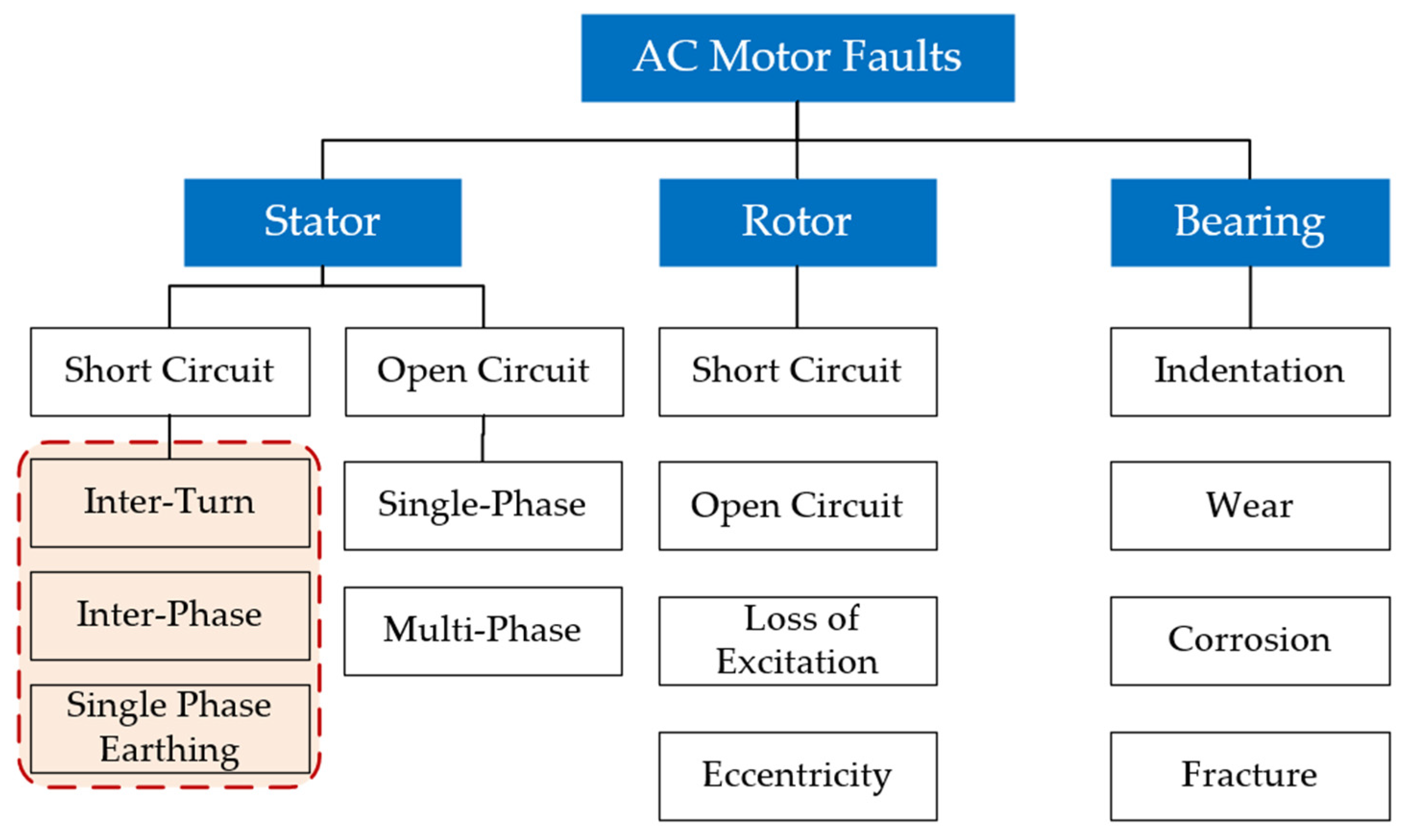

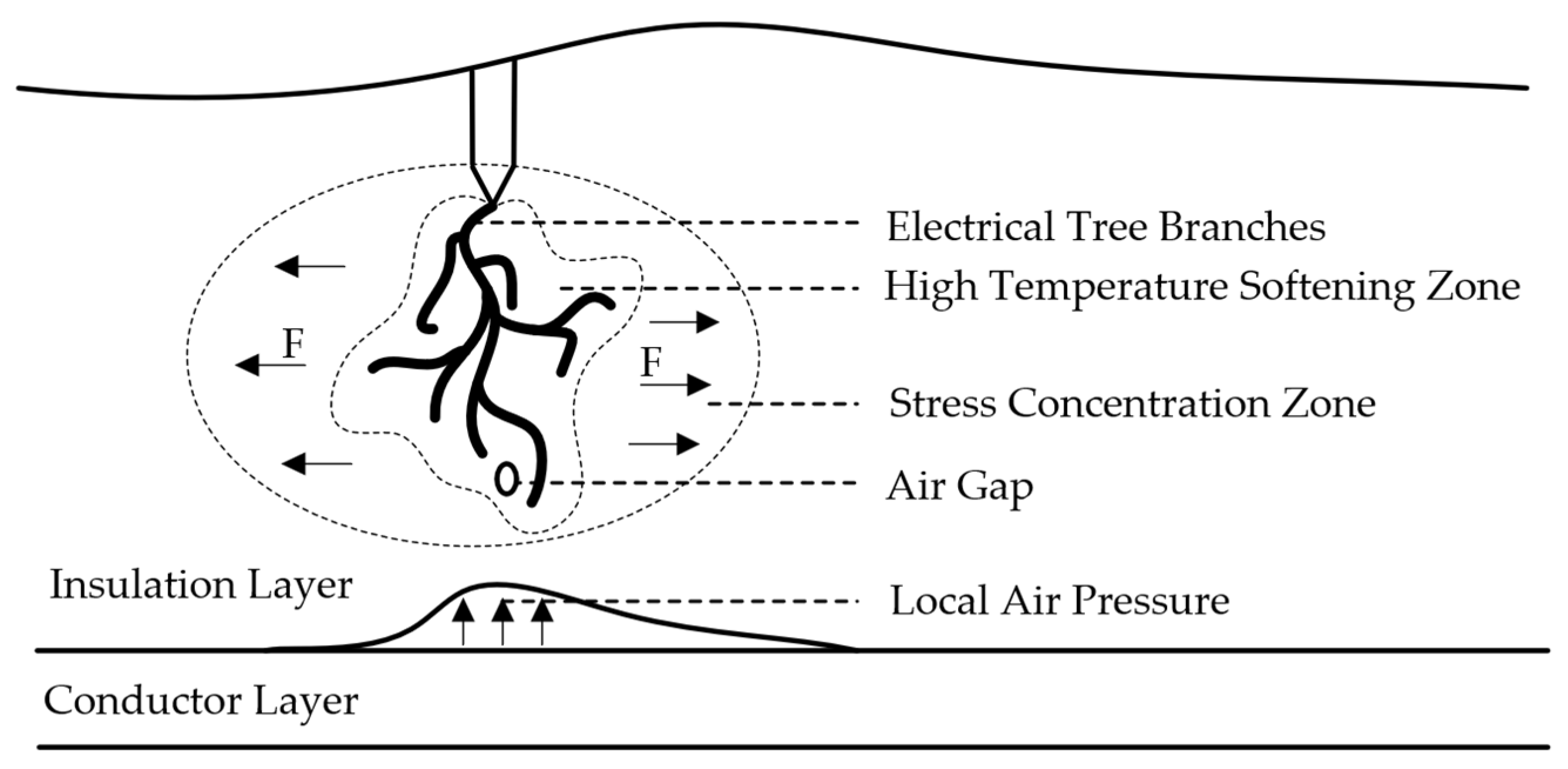

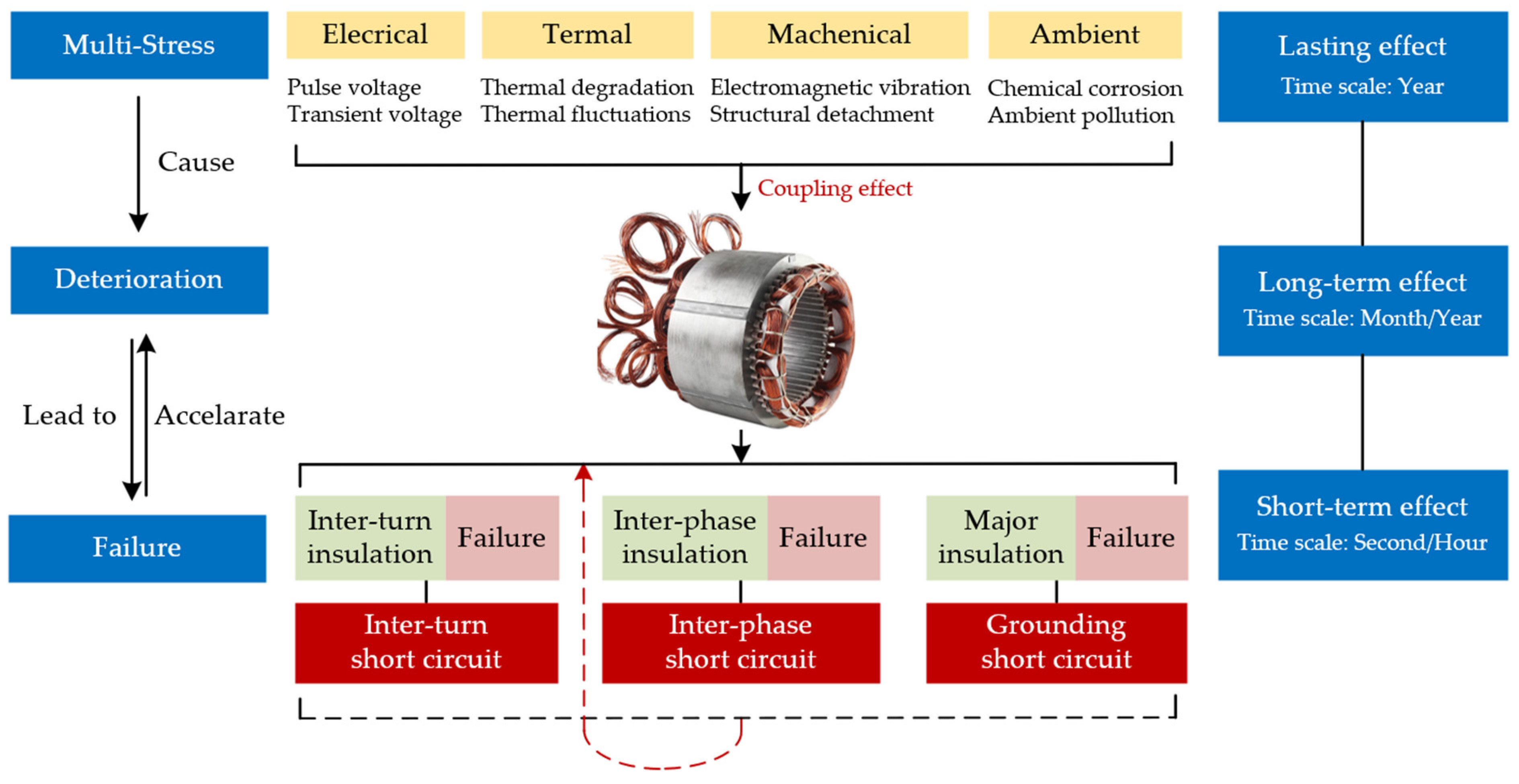
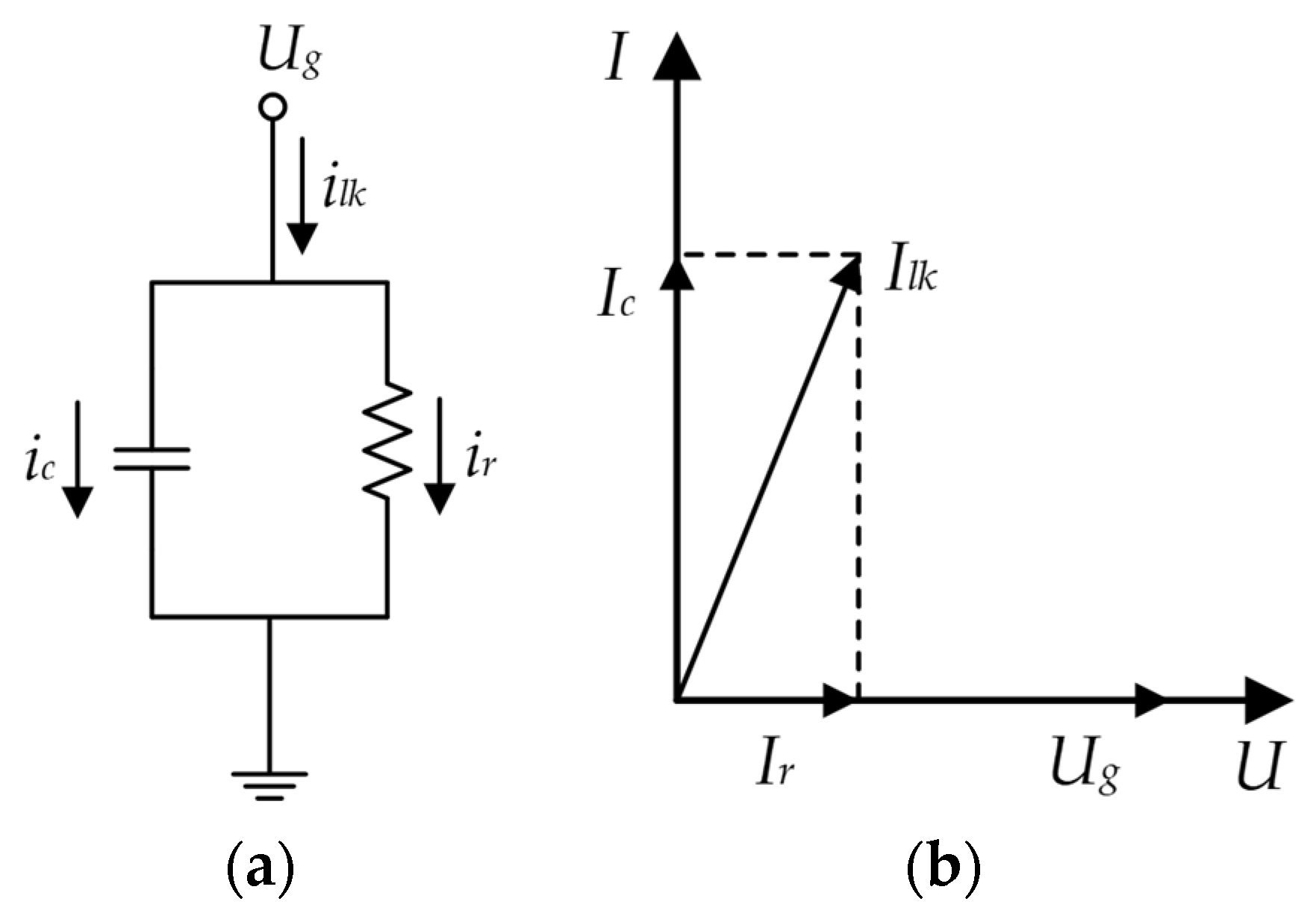
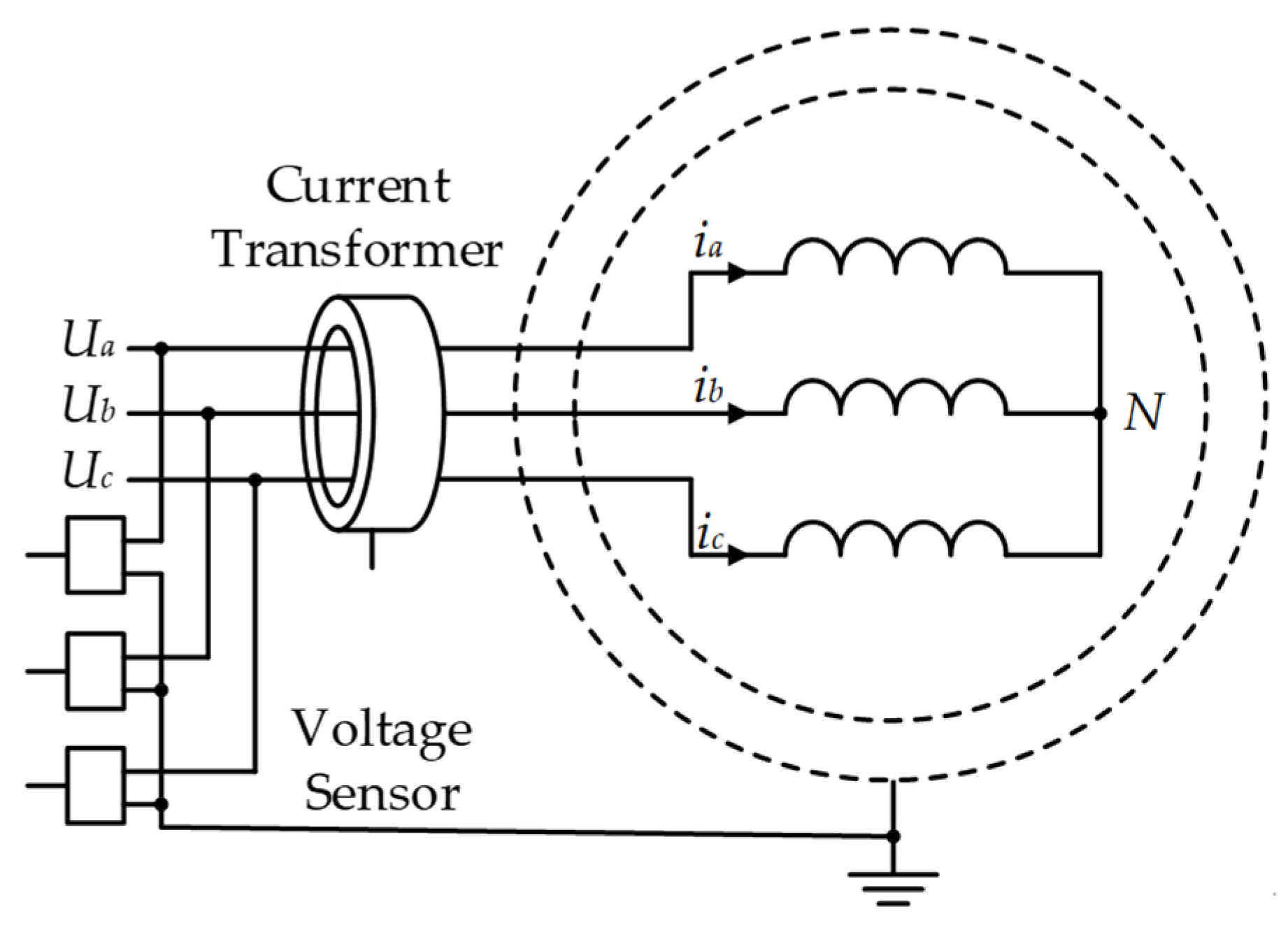
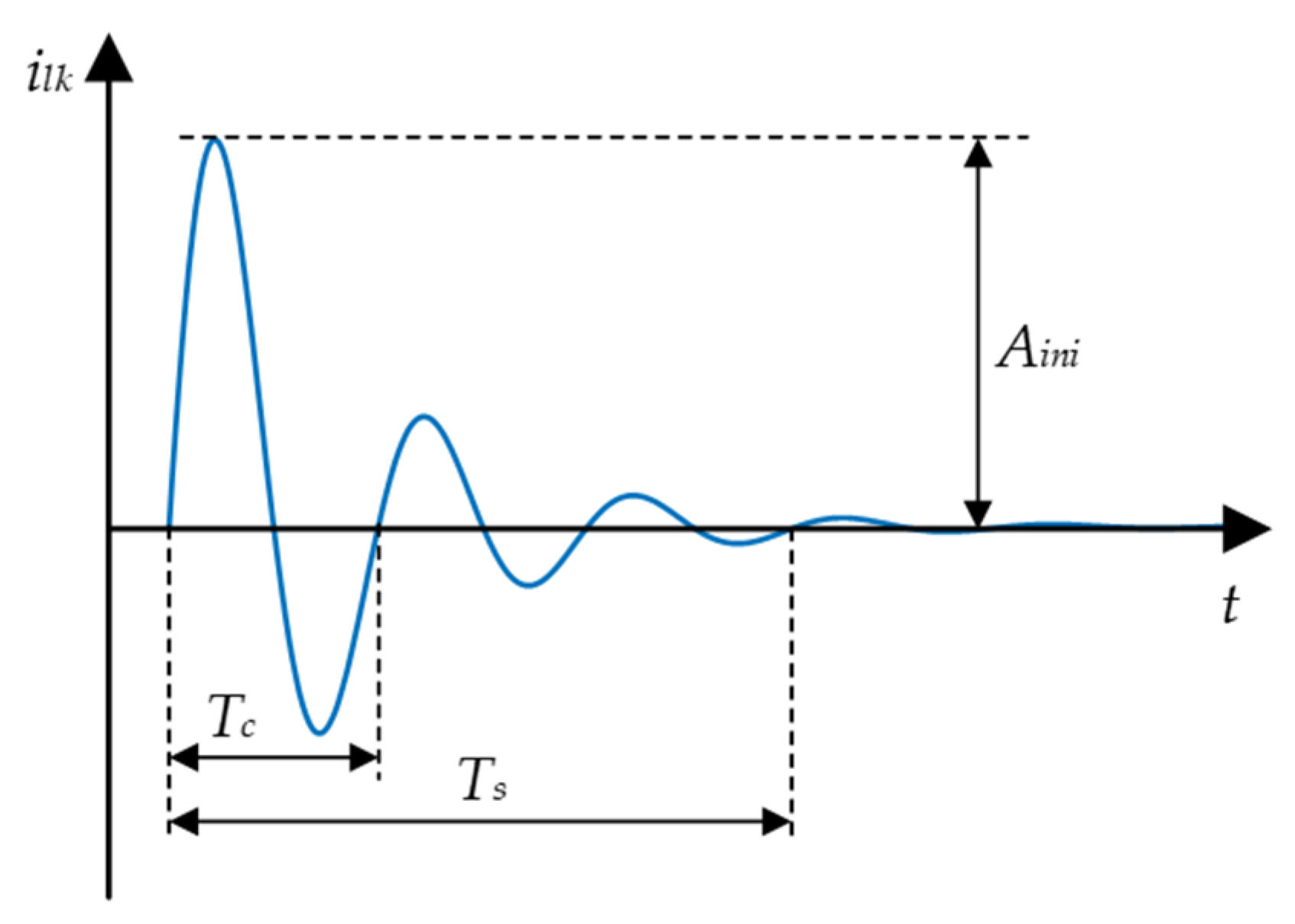
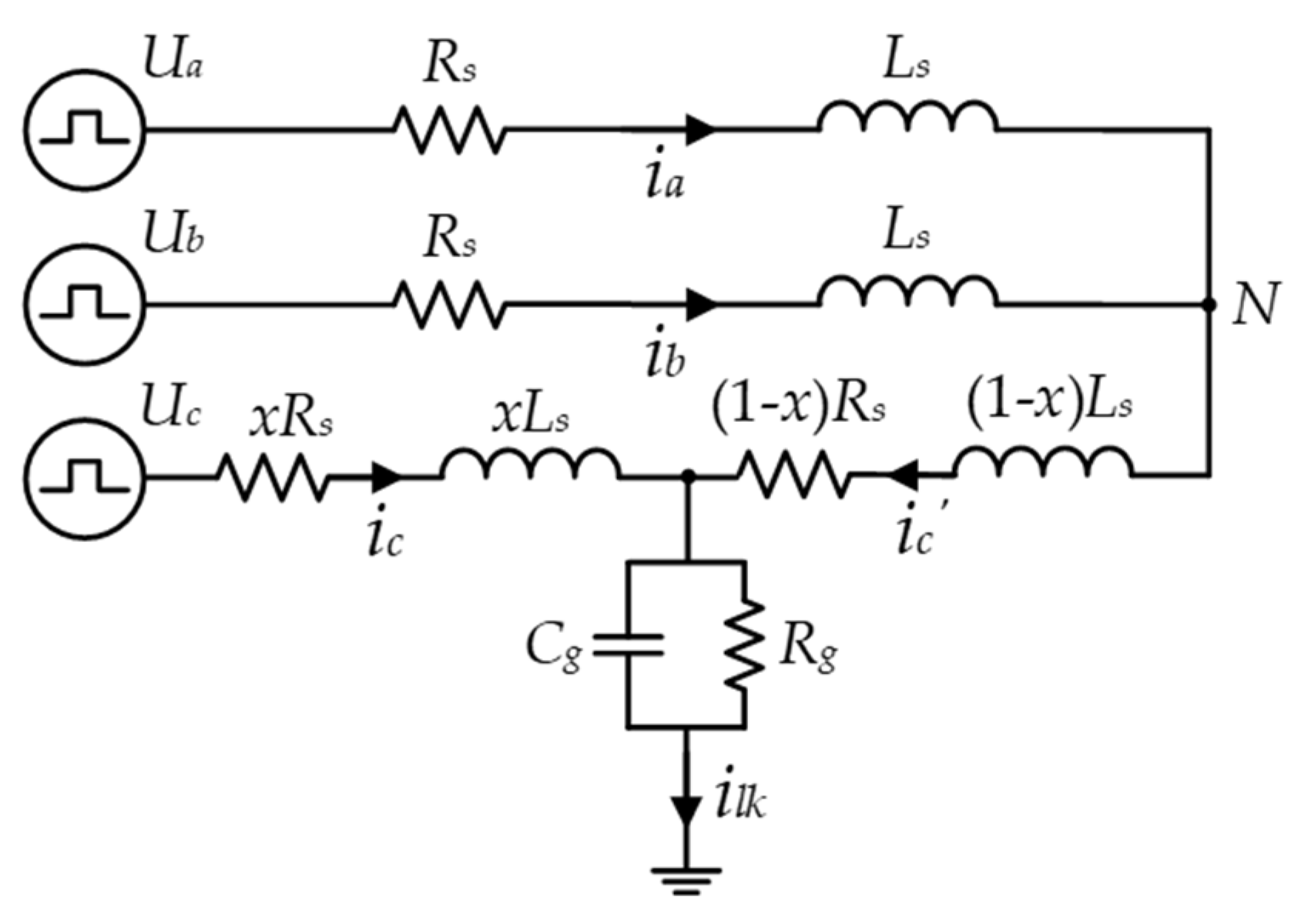

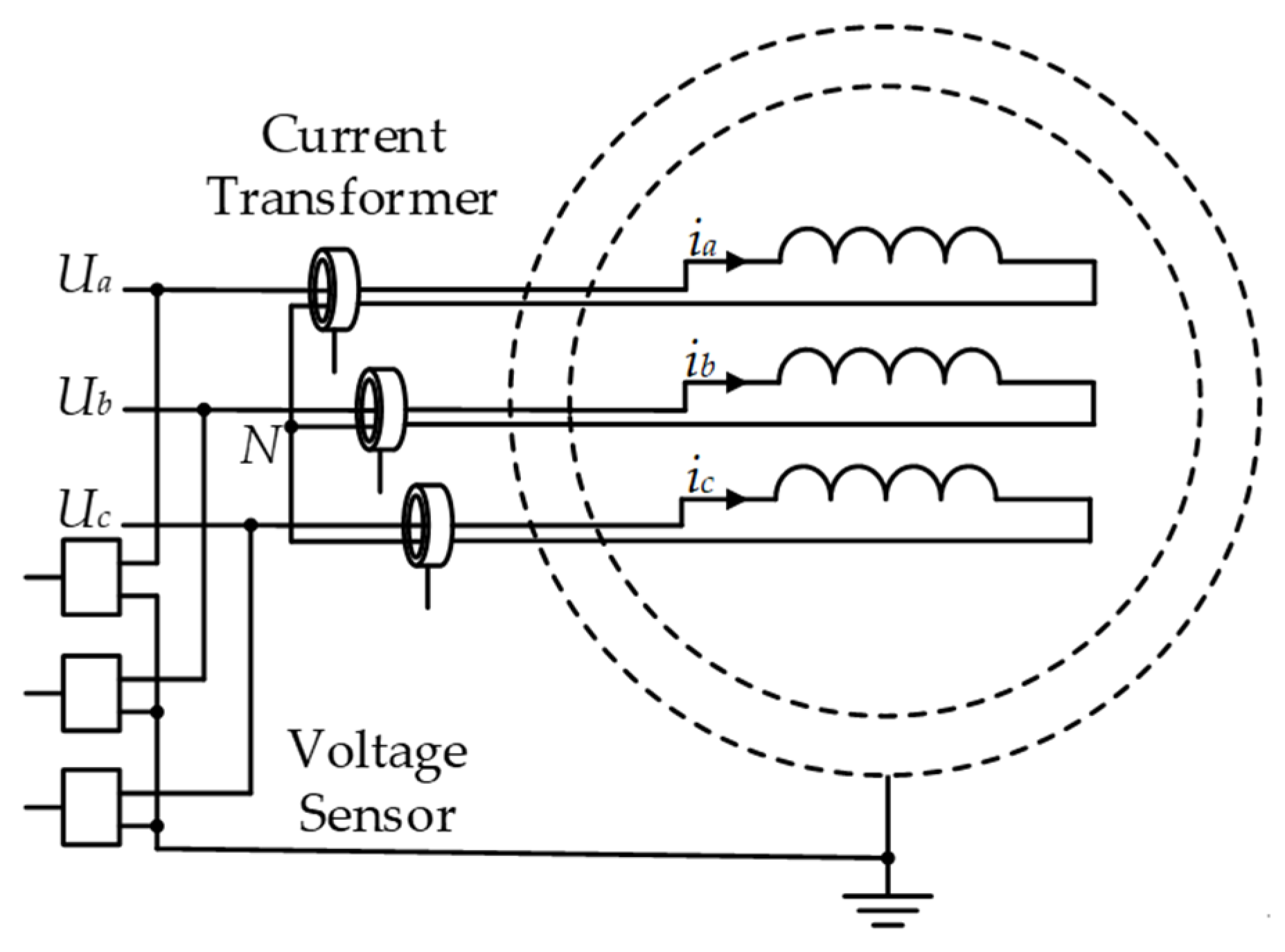
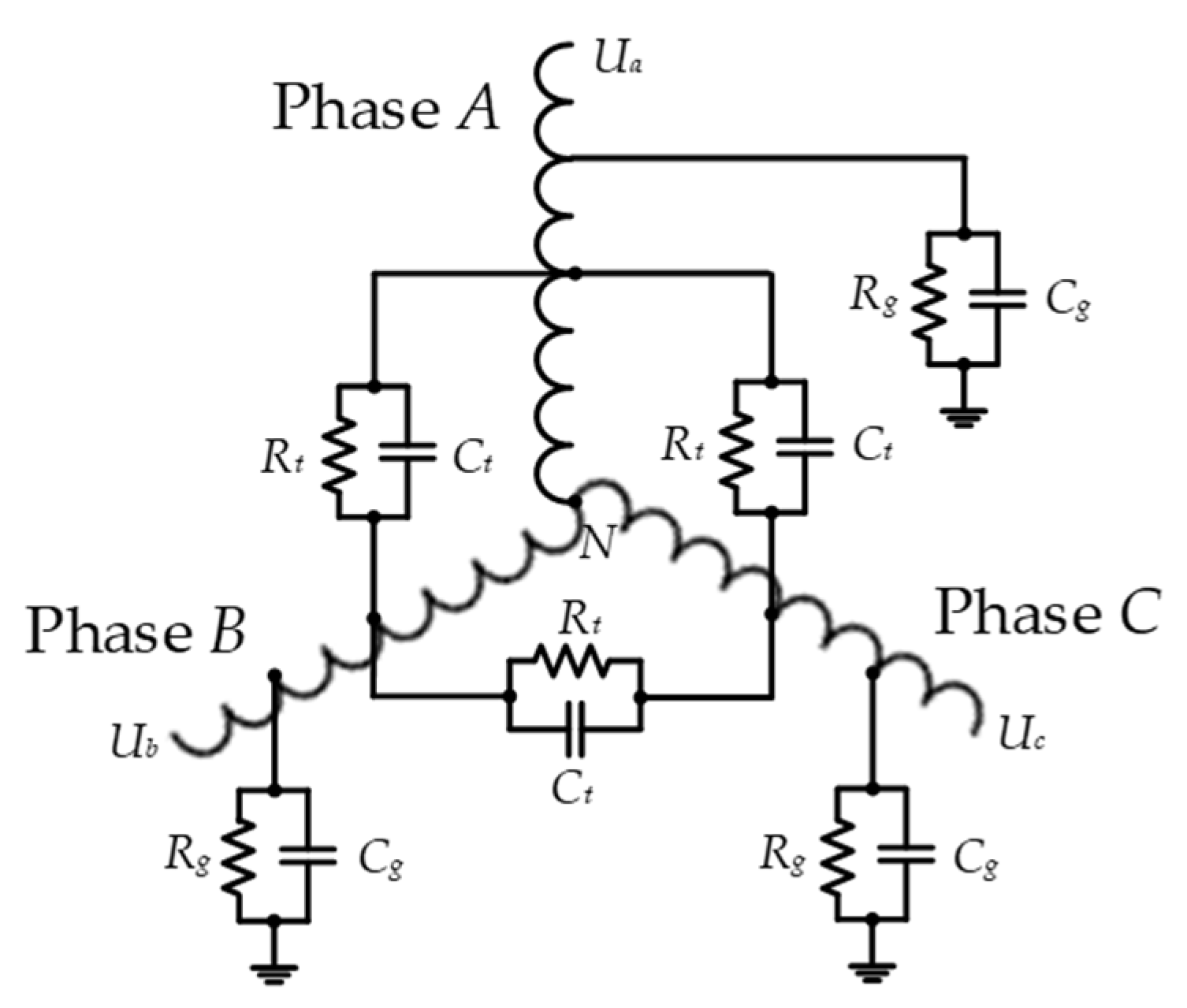

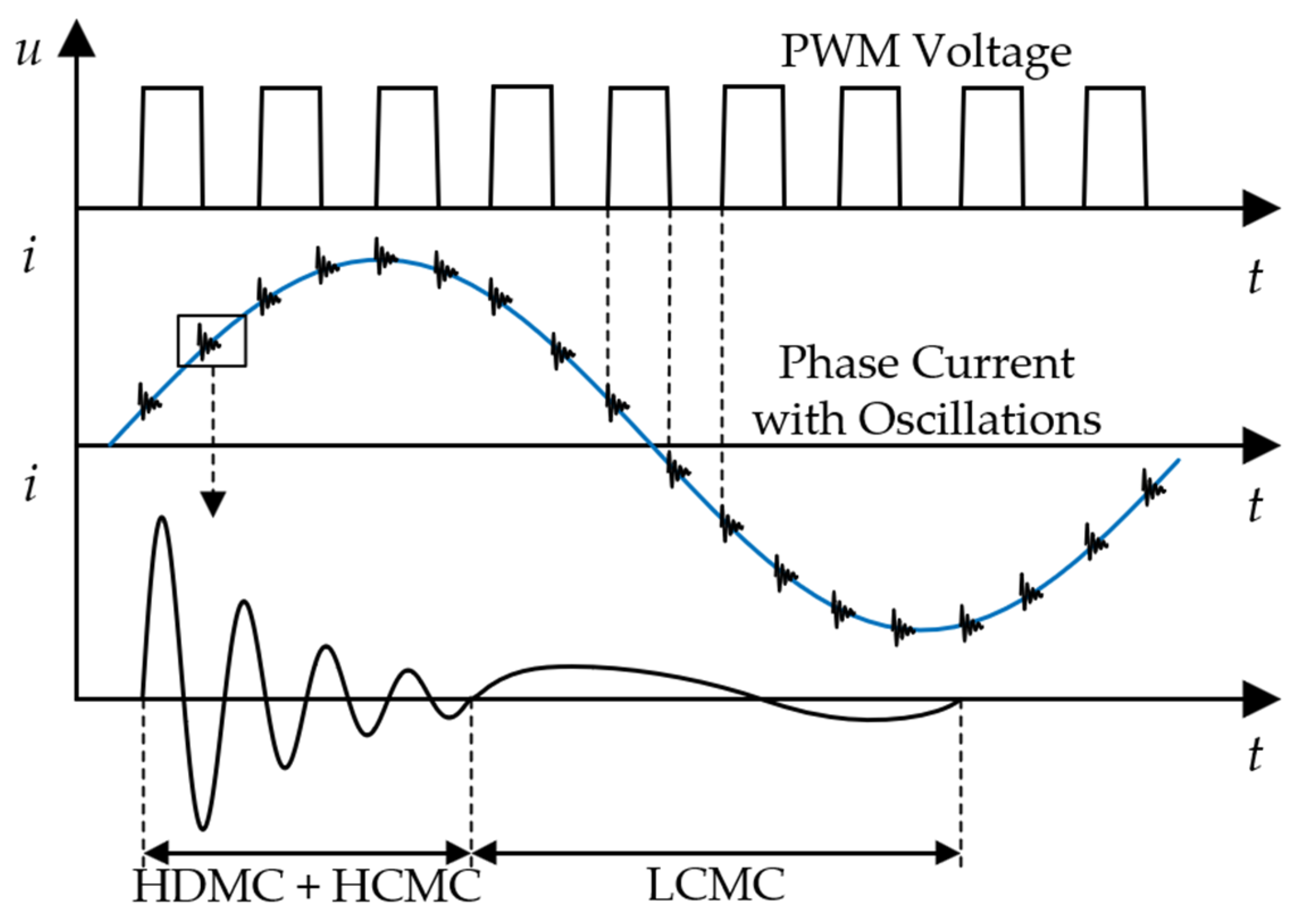

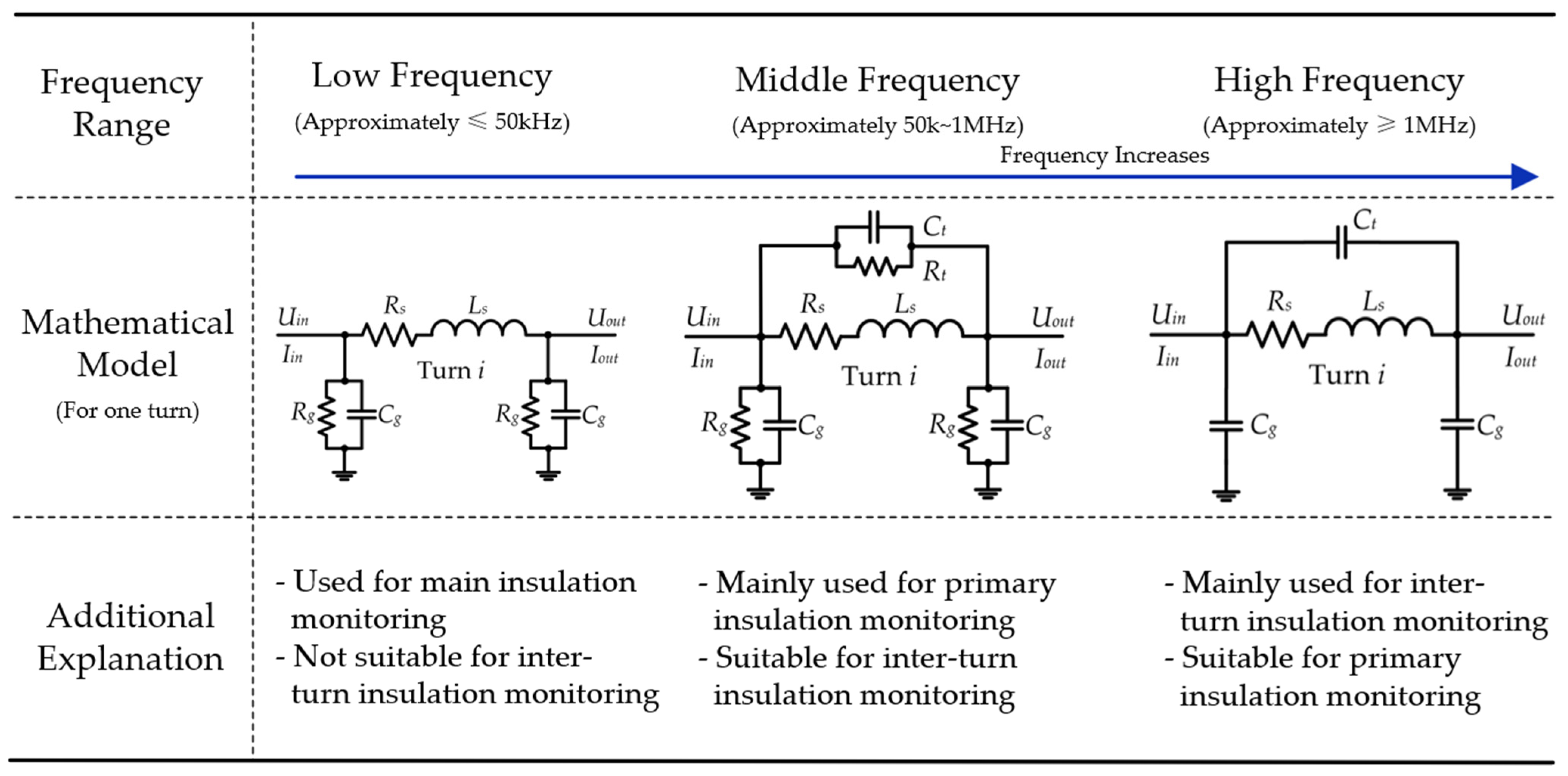
| Stress Type | Impact Factor | Performance |
|---|---|---|
| Electrical Stress | cumulative effect of high frequency pulses | insulation partial discharge |
| transient voltage | electrical tree discharge | |
| Thermal Stress | thermal degradation | deterioration of insulation materials |
| thermal fluctuation | insulation material deformation | |
| Mechanical Stress | loose wire rods in the slot | insulation material detachment |
| vibration of stator winding | wear of insulation materials | |
| Ambient Stress | dirty | corrosion of insulation materials |
| water strains | carbonization burn marks | |
| scratches | scratches on insulation materials |
| Methods | Frequency Range | Monitoring Locations | Additional Sensors | Main Advantages | Main Disadvantages |
|---|---|---|---|---|---|
| Partial Discharge | High frequency | Almost all | 1. Intrusive detection coils or antennas 2. High-bandwidth current sensors | 1. High precision 2. Able to reflect most insulation aging information | 1. Not applicable to low-voltage motors 2. Hard to balance non-invasiveness and accuracy 3. Susceptible to noise interference 4. Additional sensors required |
| Time–Frequency Characteristics | Low frequency | Primary insulation | High-sensitivity current transformer | 1. Low bandwidth requirements for sensors 2. Able to monitoring the location of degradation | 1. Unable to monitor inter-turn insulation 2. Additional sensors required |
| Broadband Impedance Spectrum | Middle frequency | Primary insulation and Inter-phase insulation and Inter-turn insulation | High-sensitivity current transformer | 1. Able to monitor multiple locations 2. Able to monitoring the location of degradation | 1. Additional sensors required 2. Higher bandwidth sensors needed 3. Hard to distinguish in cases of multi-location degradation |
| High-Frequency Current Ringing | Middle frequency High frequency | Mainly inter- turn insulation | None | 1. No additional sensors required 2. Better monitoring of inter-turn insulation | 1. Presence of multimodal aliasing 2. Potential for temporal aliasing |
Disclaimer/Publisher’s Note: The statements, opinions and data contained in all publications are solely those of the individual author(s) and contributor(s) and not of MDPI and/or the editor(s). MDPI and/or the editor(s) disclaim responsibility for any injury to people or property resulting from any ideas, methods, instructions or products referred to in the content. |
© 2024 by the authors. Published by MDPI on behalf of the World Electric Vehicle Association. Licensee MDPI, Basel, Switzerland. This article is an open access article distributed under the terms and conditions of the Creative Commons Attribution (CC BY) license (https://creativecommons.org/licenses/by/4.0/).
Share and Cite
Zou, Z.; Liu, S.; Kang, J. Degradation Mechanism and Online Electrical Monitoring Techniques of Stator Winding Insulation in Inverter-Fed Machines: A Review. World Electr. Veh. J. 2024, 15, 444. https://doi.org/10.3390/wevj15100444
Zou Z, Liu S, Kang J. Degradation Mechanism and Online Electrical Monitoring Techniques of Stator Winding Insulation in Inverter-Fed Machines: A Review. World Electric Vehicle Journal. 2024; 15(10):444. https://doi.org/10.3390/wevj15100444
Chicago/Turabian StyleZou, Zihan, Senyi Liu, and Jinsong Kang. 2024. "Degradation Mechanism and Online Electrical Monitoring Techniques of Stator Winding Insulation in Inverter-Fed Machines: A Review" World Electric Vehicle Journal 15, no. 10: 444. https://doi.org/10.3390/wevj15100444
APA StyleZou, Z., Liu, S., & Kang, J. (2024). Degradation Mechanism and Online Electrical Monitoring Techniques of Stator Winding Insulation in Inverter-Fed Machines: A Review. World Electric Vehicle Journal, 15(10), 444. https://doi.org/10.3390/wevj15100444






